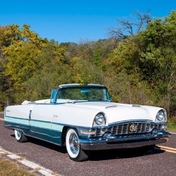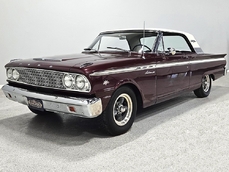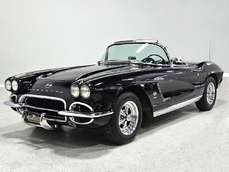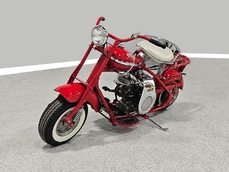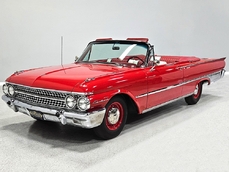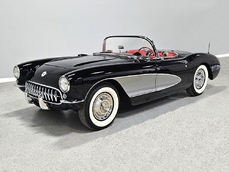Packard caribbean 327 cubic inch straight-8 1953
General description :
Packard was on the ropes in the 1950s and knew it. They bought Studebaker (not vice-versa, as many believe) but their fortunes didn’t change much. Conservative styling was probably the primary culprit, although a lot of buyers were seeing short-stroke OHV V8s in competitors’ cars, and while Packard’s straight-8s were impossibly smooth and torquey, there was an image of old tech. To solve the problem, Packard did what Packard did best: create a gorgeous high-end luxury car that combined the best they had to offer and put it in front of clientele who appreciated such things. That car was the Packard Caribbean, a bespoke luxury convertible with styling tweaked by the legendary Dick Teague and based on the Packard Cavalier convertible. A continental kit, extra chrome and stainless, a sumptuous leather interior, and a high-output 180 horsepower version of their 327 cubic inch straight-8 all combined to draw customers into Packard showrooms one last time. They were hand-built by the Mitchell-Bentley Corp. in Ionia, Michigan and only 750 were built. With a price tag of $5210, they were among the most expensive cars you could buy, weighing in at a staggering $1400 more than a comparable Cadillac.
The Caribbean was built for four years, and each enthusiast has their own favorite style, but a great many believe that the 1953 Caribbean was the purest, most elegant design and the last of the truly great straight-8 Packards. The radiused rear wheel openings are the primary difference and it’s significant—the ’53 looks sporting and lithe, while later cars with skirts tended towards heavy and ponderous. Then there’s the color combination on this car, which is Packard Ivory over red leather, a late addition to the roster and available as special-order only. Some estimates suggest that fewer than 10 (out of 750 total 1953 Caribbeans) were painted this color, making it a highly desirable car among highly desirable cars. In 2012, this Caribbean was treated to a bare metal respray and the finish still shows extremely well, with a soft shine that’s entirely appropriate for a product of the 1950s. Gaps are very good, and yes, that hood scoop—which was hand-fashioned out of lead on the assembly line—looks better than ever. Most of the chrome was refinished at that same time and shows beautifully today, particularly the distinctive trim around the wheel arches and along the sills. The Caribbean also wears unique chrome details along the belt line and on the rear quarters, forming miniature tail fins before such things were truly fashionable. The result is a car that looks fantastic from any angle.
The red leather interior is exactly the right choice with the Ivory bodywork, creating a flashy yet sophisticated contrast that feels sporting not dated. The hides are in great condition with only minimal signs of use and no tears, splits, or scuffs on the seating surfaces. Matching red carpets are deep and plush, helping to keep the interior quiet and comfortable and the simple door panels are an exercise in good taste and restraint. The standard Packard dashboard puts a three-gauge pod ahead of the driver, and this car carries original, unrestored gauges that are the only part of the interior that hasn’t been freshened. All the gauges work except the speedometer and clock, and things like the innovative warning lights, heater/defroster, and even the radio and power antenna are fully operational. The big ivory plastic steering wheel has obviously been restored and shows quite well with no cracking and the horn ring looks good, showing only very, very minor pitting that suggests it’s original. Packard logo floor mats protect those plush carpets and this car is equipped with optional power windows that all go up and down easily and the power seat works as it should. There’s also a black canvas power convertible top that folds easily and stows under a matching black boot, and we have to admit that this is one great-looking convertible. The trunk is positively massive and has been trimmed with matching red carpets—note that the spare tire well is still in place but obviously the spare tire is on the rear bumper in the continental kit.
There are a lot of folks who believe that a Packard isn’t a Packard without a straight-8 engine under the hood, and the ultra-smooth and surprisingly powerful 327 cubic inch straight-8 used in 1953 is a great runner. With a 4-barrel carburetor and a rather 8.0:1 compression ratio, it makes 180 of the most creamy-smooth horsepower you’ve ever experienced. Perhaps even more significantly, there’s 300 pounds of torque on tap at just 2000 RPM. There’s nary a vibration or shudder and effortless torque at any speed. That’s what owning a Packard is all about. The engine was rebuilt to stock specifications in 2012 and has not been driven much since then so it’s still fresh. It starts quickly and easily with the accelerator pedal-mounted starter switch and idles smoothly and almost silently after a few moments on the choke. Corporate gray engine enamel is a little industrial for the high-end Caribbean, but that’s how it was in 1953. There are new ignition components, fresh belts and hoses, and the hydraulic pump for the windows and top was rebuilt. The heavy-duty oil bath air cleaner looks right and you’ll note power steering is part of the deal, making this Packard extremely easy to handle.
We don’t believe the body has ever been off the frame, but on a clean car it’s not really necessary. The chassis is coated in a layer of black undercoating, presumably to seal and protect rather than hide, and we can’t find any evidence of rot or previous damage. There are minor signs of use, but it’s quite clean overall and someone has obviously been sweating the details in the mechanics department—there are new components on the power steering system, fresh shocks at all four corners, the brakes show newer hoses and stop firmly, and a correct reproduction exhaust system (with two mufflers) was just installed. Packard’s “UltraMatic” 2-speed automatic transmission isn’t sophisticated but it’s durable and smooth, and the smooth straight-8 makes so much torque that it rarely needs a downshift. 3.54 gears in the rear axle make this car feel quick and lively around town despite its rather hefty 4100-pound curb weight and it’s a smooth, comfortable cruiser at 65 MPH. Gorgeous chrome wire wheels (not hubcaps) look properly upscale and carry recent 225/75/15 wide whitewall radials that really upgrade the ride and handling.
Beautiful to look at and delightful to drive, the Caribbean embodies all the traditional Packard values that make the marque so special. Look carefully and see if you don’t agree that this is one of Packard’s great works and it certainly doesn’t look like a car built by a company that knew the end was coming. With a rare color combination and great road manners, this will quickly become one of your favorite cars to drive. Call today!
Harwood Motors welcomes and encourages personal or professional inspections of any vehicle prior to purchase.
http://www.harwoodmotors.com/vehicles/inventory_details.php?id=1120
1953 Packard caribbean 327 cubic inch straight-8 is listed sold on ClassicDigest in Macedonia by for $69900.
Car Facts
Car type : Car Make : Packard Model : caribbean Model Version : 327 cubic inch straight-8 Engine size : 0.0 Model Year : 1953 Location : Ohio
Sold
Seller Information
Sold
People who viewed this Packard caribbean also viewed similar Packard listed at ClassicDigest
Other cars listed for sale by this dealer
About Packard
Packard: A Comprehensive HistoryEarly Years and Foundation:
Founding: The Packard Motor Car Company was established in 1899 in Warren, Ohio, by James Ward Packard, William Doud Packard, and George Lewis Weiss.
Pioneering Luxury: Initially producing high-quality automobiles, Packard became synonymous with luxury, craftsmanship, and engineering excellence.
Notable Achievements and Contributions:
Packard Twin Six: Introduced in 1916, this V12-powered car established Packard as a premier luxury automobile brand.
Model Line Expansion: Packard expanded its lineup with various models, including sedans, coupes, convertibles, and limousines, catering to affluent customers seeking elegance and performance.
Engineering Innovations: The brand introduced several innovations, such as the first use of aluminum pistons, air conditioning, and the Ultramatic automatic transmission.
Ten Historically Significant Models with Technical Specifications:
Packard Twin Six (1916):
Engine: 7.3L V12 engine.
Performance: Around 85 horsepower.
Packard Eight (1930-1938):
Engine: Straight-8 engine with various displacements.
Performance: Ranged from 90 to over 130 horsepower.
Packard Super Eight (1939-1951):
Engine: Straight-8 engine.
Performance: Produced between 130 to 180 horsepower.
Packard One-Twenty (1935-1942):
Engine: Straight-8 engine.
Performance: Approximately 100 to 120 horsepower.
Packard Clipper (1941-1957):
Engine: V8 engine.
Performance: Ranging from 135 to 185 horsepower.
Packard Caribbean (1953-1956):
Engine: V8 engine.
Performance: Varying between 275 to 310 horsepower.
Packard Patrician (1951-1956):
Engine: Inline-8 and V8 engines.
Performance: Ranged from 150 to 180 horsepower.
Packard Hawk (1958):
Engine: V8 engine.
Performance: Produced around 275 horsepower.
Packard Executive (1956-1958):
Engine: V8 engine.
Performance: Varying between 240 to 290 horsepower.
Packard Predictor (1956):
Engine: Concept car showcasing design and technology.
Performance: Prototype model.
Legacy and Influence:
Quality and Elegance: Packard was revered for its exceptional build quality, refined styling, and luxury features, often considered on par with European luxury brands like Mercedes-Benz.
End of Production: The brand faced financial struggles in the 1950s, leading to its merger with Studebaker and eventual discontinuation in the late 1950s, marking the end of an era in American luxury automobiles.
Packard left an enduring legacy in the automotive industry, symbolizing elegance, engineering excellence, and a commitment to luxury that has been admired and respected by car enthusiasts worldwide.

















